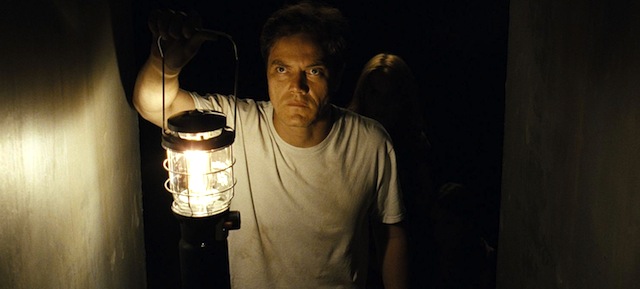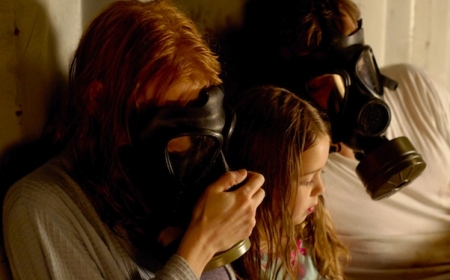
Premonitions of a storm coming, a storm that turns your loved ones into something they are not–strangers dangerous, poisoned, violent. The storm comes and things are taken–the life you’ve known is under alarming arrest–and your power to resist it is futile. The storm stands in your window and stares at your children, it surreal, god-like lifts your home and all that is within it, it rips from you the order you’ve had in control up to this point and gives you the life of Job–a storm-squalled widower made widower by a private act of God.
Well, it’s easy to say in reviewing the plot points of Take Shelter, Jeff Nichols’ second feature project with Michael Shannon, that this is an interesting story about mental illness and paranoia, on its affects on the immediate community. It’s easy to say that Jeff Nichols, like his previous project with Shannon, Shotgun Stories, is all about these family-stories-gone-far-too-macabre, that he’s a great teller of interesting stories that get you wondering. Both of these interpretations are distancing interpretations, and Nichols doesn’t seem to want to be just talking about mental illness, much less giving an apocalyptic narrative, but instead about the everyday apocalypse, the everyday end-of-the-world. What I’m talking about is the universally understood paranoia of control, the tireless taking shelter from Life’s will to disarm you. It is within this anxious apocalypse that Shannon’s character, Curtis, finds himself immured.
The plot plays by a classic slow-rolling conflict. Curtis and his wife Samantha (Jessica Chastain) have a sincere marriage, a beautiful child, Hannah (Tova Stewart), who has recently lost her hearing. In accommodating the circumstances, Curtis and Samantha are learning sign language in night classes, are looking into expensive surgeries, are making sure their health coverage will take care of it. It’s all moving towards some perceived collapse, and you don’t know what it is until Curtis begins having his dreams–and what dreams they are. Immense thunderhead clouds with multiple tornadoes, oil-rain, venomous dogs, murderous best friends, murderous wives. Everything turns on its head–everything goes wrong–and Curtis in his dreamstate is fighting to protect those he cannot save from everyone else trying to kill him. And from the audience it’s hard not to believe that these visions have some tangible connection to Hannah’s unexpected and tragic disability.
Curtis’ response is our response to our anxieties. It is bifurcated and hidden. He begins living a double life in the silence of his own fears. Confronted with the paranoia and helplessness that these dreams conjure, Curtis turns inward, and decides to deal with them in the only ways he knows possible. If the anxieties are not true, if these fears are growing inside him–but are groundless–he is crazy and needs help. He begins seeing a therapist, he visits his estranged mother (which informs the audience that paranoid schizophrenia runs in the family), he gets some medication. What if the anxieties are true, though? (Have you done this before?) What if he is not crazy and needs to get ready for a storm that is trying to announce itself? What if a storm really is coming? Well, then, you build a shelter. Maybe he’s crazy, maybe he’s not–is he? are we?–he’s trying everything he can to shelter himself in from within and without.
You cannot stop what’s coming, and particularly when what’s handled is handled halfway and in secret, it has all sorts of effects on your relationships. It is Curtis’ inner-confliction that should have earned Shannon the Oscar. Being ashamed of anxieties, he hides them from Samantha; hiding them from Samantha, he leaves love out of the picture, and takes shelter within himself. His fear has cast his anxious mind deep within himself, and so his fear has cast out love. Samantha can only respond with confusion and anger. It is this fear-driven isolation and fear-driven control-seeking, that pushes Curtis from his family; as the visions intensify, the storm shelter work eats away his relationship with his best friend and his wife. He loses his job. The health care for his daughter’s surgery is canceled. The stability he seeks has created a frenzied loss of all control; his rock bottom is as dark and lonesome as the generator-whirring of his shipping container, his grave. All has gotten startlingly neurotic, and Shannon does an impeccable job of being both someone whom the audience fears and, startlingly, knows. This scene alone shows the violence of fear and the quiet (and irrational) faith of love.
[youtube=http://www.youtube.com/watch?v=ey1Z0VhAQdA&feature=related&w=550]
Samantha’s patient love stills Curtis’ fury, but she cannot understand him, and her love cannot heal until it goes fully into the heart of his premonition’s storm. Her love must have his pain imputed upon her, and vice versa. Enduring with him until the shelter (now replete with plumbing and ventilation!) is finished, Samantha uses a routine thunderstorm one night to bring the entire family into the shelter. She and Hannah carry on as though Curtis’ apocalypse is their own apocalypse–the gas masks and all–and allow the Curtis the satisfaction of knowing that his anxieties, his premonitions are true. This is an interesting moment, as it shows that Samantha empathizes for the truth of his storm, regardless of its objective reality–it is nonetheless as affecting and true as it would be were it objectively real. And so she goes there.
After some time, after descending into the heart of the pit–this hellish container wrought by fear, the fear that lost the job, killed the friendship, hurt the marriage, ruined his name–love names it new by opening it again. When Samantha prompts him to open the shelter door when the rain stops, Curtis asks, “How do you know the storm is over?” Curtis tells Samantha he cannot open it on his own, that Samantha must open it, to which Samantha replies, “If you don’t open it yourself, nothing will change.” He must let Life in–he must surrender his tightfisted-panic-grip and accept the shelter of no-shelter, the power of powerlessness. Only in opening the doors and letting in the conditions will he find the life he lost–only in accepting his defeat and giving it over can anything be given back. He now has the burden of doing so lifted, because he’s no longer doing it alone. It’s being carried in love, for him. He opens the shed and, in Easter splendor, the skies are blue, the neighbors are out, and life is returned.
Now, there’s been plenty of talk about the ending after the ending, the ending no one likes, the ending with no answers. I’m referencing the final scene where apocalypse is now seen by mother and daughter, not just Curtis. The blogosphere is arrayed with interpretations on this final scene, most of whom conclude that Curtis was right all along, that the storm was on its way, and now it’s really happening. I tend to disagree. It seems that, in the event that real imputation has taken place, and his family now carries his storm in them–he is not alone in his experience of the storm. They see it with him. He still sees the storm–he does not experience it alone. It’s an ending that points to love–as much as it truly goes there with someone–as that perfect power which casts out the fear-ridden storm-chasing Curtis in us all. It bears our fears with us. Love carries our storm, too.

COMMENTS
Leave a Reply














